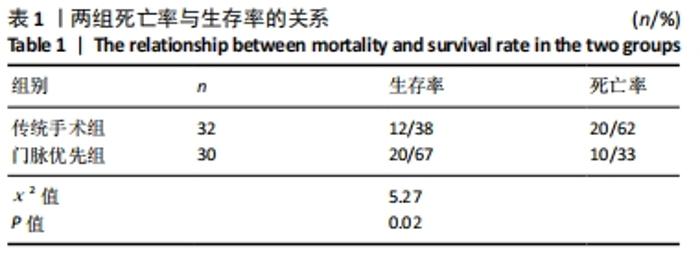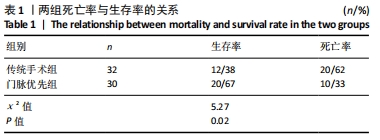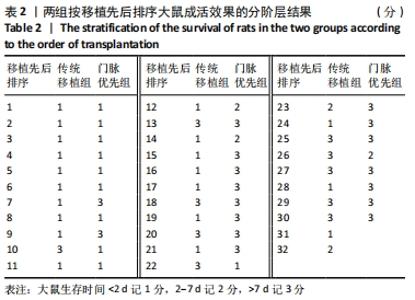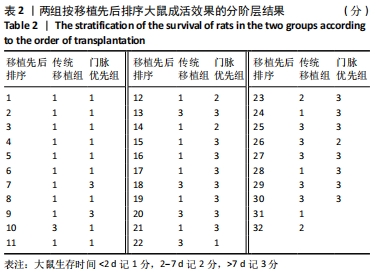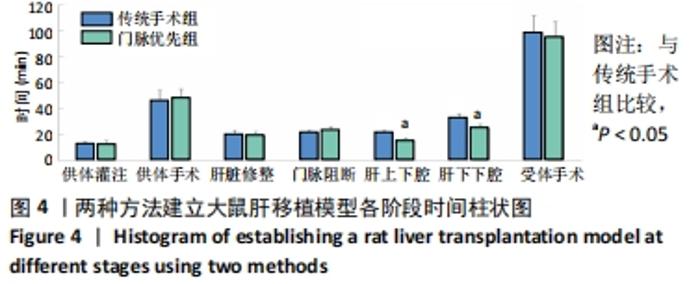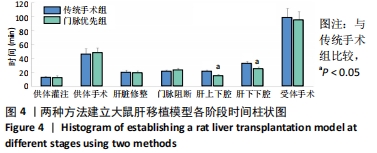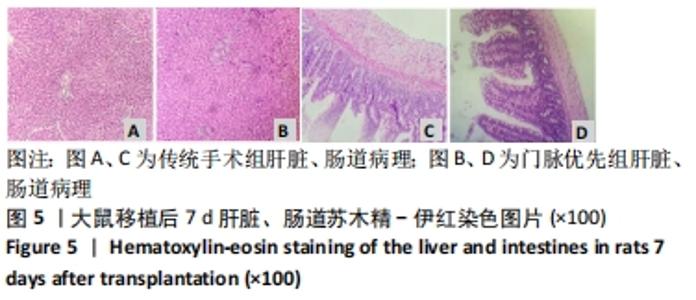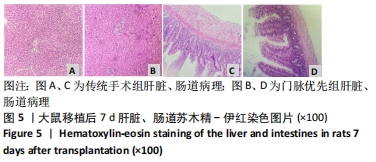[1] SUN Z, LI T, WEN H, et al.Immunological effect induced by mesenchymal stem cells in a rat liver transplantation model. Exp Ther Med. 2015;10(2):401-406.
[2] CHENG Y, LAN H, CHEN Y, et al. Protective Effect of Retrograde Reperfusion Against Hepatic Autophagy Impairment in Rat Liver Transplantation. Transplant Proc. 2021;53(1):443-449.
[3] BRUINSM BG, BERENDSEN TA, IZAMIS ML, et al. Supercooling preservation and transplantation of the rat liver. Nat Protoc. 2015;10(3):484-494.
[4] LI M, LU C, ZHU H, et al. Cenicriviroc ameliorates the severity of graft-versus-host disease through inhibition of CCR5 in a rat model of liver transplantation. Am J Transl Res. 2019;11(6):3438-3449.
[5] WESTERKAMP AC, FUJIYOSHI M, OTTRNS PJ, et al. Metformin Preconditioning Improves Hepatobiliary Function and Reduces Injury in a Rat Model of Normothermic Machine Perfusion and Orthotopic Transplantation. 2020;104(9):e271-e280.
[6] CHEN X, WANG L, DENG Y, et al. Inhibition of Autophagy Prolongs Recipient Survival Through Promoting CD8+ T Cell Apoptosis in a Rat Liver Transplantation Model. Front Immunol. 2019;10:1356.
[7] 赵英鹏,李立,陈刚.减体积肝移植在大鼠脂肪肝供肝肝移植模型中的应用[J].中国组织工程研究,2018,22(4):582-586.
[8] CHONG AS, ALEGRE ML, MILLER ML, et al. Lessons and limits of mouse models. Cold Spring Harb Perspect Med. 2013;3(12):a015495.
[9] KAMADA N, CALNE RY. Orthotopic liver transplantation in the rat. Technique using cuff for portal vein anastomosis and biliary drainage.Transplantation. 1979;28(1):47-50.
[10] KAKIZAKI Y, MIYAGI S, SHIMIZU K, et al. The Effects of Short-term Subnormothermic Perfusion After Cold Preservation on Liver Grafts From Donors After Circulatory Death: An Ex Vivo Rat Model. Transplantation. 2018;102(4):e147-e154.
[11] 李蕾,李善宝,汪涛.单人直视下大鼠肝移植模型供肝获取不同灌注方式比较[J].器官移植,2020,11(3):356-361.
[12] 陈辉,姜骊,王雁.三种不同麻醉药对SD大鼠肝移植手术麻醉效果的比较和应用[J].实验动物科学,2009,26(4):57-59+62.
[13] JIA JJ, LI JH, YU H, et al. Machine perfusion for liver transplantation: A concise review of clinical trials. Hepatobiliary Pancreat Dis Int. 2018;17(5):387-391.
[14] GASSNER JMGV, NOSSER M, MOOSBURNER S, et al. Improvement of Normothermic Ex Vivo Machine Perfusion of Rat Liver Grafts by Dialysis and Kupffer Cell Inhibition With Glycine. Liver Transpl. 2019;25(2):275-287.
[15] JIA L, YU W, YU H, et al. Electroacupuncture Pretreatment Attenuates Intestinal Injury after Autogenous Orthotopic Liver Transplantation in Rats via the JAK/STAT Pathway. Oxid Med Cell Longev. 2020;2020:9187406.
[16] QU B, YU F, SHENG GN, et al. Protective Effect of a Novel Technique for Liver Transplantation in the Rat. Transplant Proc. 2018;50(1):267-273.
[17] XIONG L, WANG D, LIN S, et al. Soluble CD83 inhibits acute rejection by up regulating TGF-βand IDO secretion in rat liver transplantation. Transpl Immunol. 2021;64:101351.
[18] ZHAO Z, PAN G, TTANG C, et al.IL-34 Inhibits Acute Rejection of Rat Liver Transplantation by Inducing Kupffer Cell M2 Polarization. Transplantation. 2018;102(6):e265-e274.
[19] 骆助林,汪涛,田伏洲.大鼠无肝期耐受门静脉血流阻断的安全时限研究[J].山东医药,2012,52(43):11-13.
[20] 周京安,李宁.肠道耐受淤血-再灌注损伤的安全时限观察[J].临床与实验病理学杂志,2010,26(3):339-344.
[21] WANG J, YU S, LI J, et al.Protective role of N-acetyl-l-tryptophan against hepatic ischemia-reperfusion injury via the RIP2/caspase-1/IL-1β signaling pathway. Pharm Biol. 2019;57(1):385-391.
[22] YUAN Y, CHEN MH, HUANG J, et al.Organ Ischemia-Reperfusion Injury by Simulating Hemodynamic Changes in Rat Liver Transplant Model. J Vis Exp. 2021; (169). doi: 10.3791/61779.
[23] LI X, WANG L, YANG X, et al.Metformin Attenuates Ischemia-reperfusion Injury of Fatty Liver in Rats Through Inhibition of the TLR4/NF-κB AxisBalkan Med J. 2020;37(4):196-202.
[24] BEJAOUI M, ZAOUALI MA, SAKLE R, et al.Olprinone protects the liver from ischemia-reperfusion injury through oxidative stress prevention and protein kinase Akt activation. Can J Physiol Pharmacol. 2018;96(3):227-231.
[25] ZAZUETA C, BUELNA-CHONTAL M, MACIAS-LOPEZ A, et al.Cytidine-5’-Diphosphocholine Protects the Liver From Ischemia/Reperfusion Injury Preserving Mitochondrial Function and Reducing Oxidative Stress. Liver Transpl. 2018;24(8):1070-1083.
[26] 唐丹,袁泉,王志超.冠状动脉支架在弯曲血管中的血流动力学分析[J].中国组织工程研究,2018,22(22):3563-3568.
[27] 刘洪涛,李永国.受体肝分步切除三袖套法大鼠原位肝移植术的改进[J].中国现代手术学杂志,2006,10(2):106-108.
[28] 何宇涛,周焘,李晓凯.大鼠肝移植中veno-lined支架技术的改良研究[J].中华器官移植杂志,2020,41(11):687-691.
[29] PECORA RA, CANEDO BF, ANDRAUS W, et al. Portal vein thrombosis in liver transplantation. Arq Bras Cir Dig. 2012;25(4):273-278.
[30] ONDA S, FURUKAWA K, SHIRAI Y, et al. New classification-oriented treatment strategy for portal vein thrombosis after hepatectomy. Ann Gastroenterol Surg. 2020;4(6):701-709.
|
